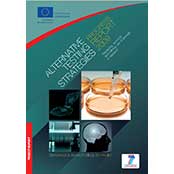Progress report 2009
Foreword 11
1. Introduction 13
1.1 Human safety, products safety 14
1.2 The 3Rs Principle and the legislative framework 15
1.3 Often-expressed concerns about the replacement
of animals in scientific experiments 16
1.4 Institutions and organisations in the field of safety
assessment and alternative testing methods 18
2. Projects supported by the EU
Health programme 21
2.1 Cell-based technologies 25
ReProTect Development of a novel approach in hazard and
risk assessment of reproductive toxicity by a combination and
application of in vitro, tissue and sensor technologies 26
VITROCELLOMICS Reducing animal experimentationin
preclinical predictive drug testing by human hepatic in vitro
models derived from embryonic stem cells 61
MEMTRANS Membrane transporters: in vivo models for the
study of their role in drug fate 72
EXERA Development of 3D in vitro models of estrogenreporter
mouse tissues for the pharmaco-toxicological analysis
of nuclear receptors-interacting compounds (NR-ICs) 83
INVITROHEART Reducing animal experimentation in drug
testing by human cardiomyocyte in vitro models derived from
embryonic stem cells 94
LIINTOP Optimisation of liver and intestine in vitro models for
pharmacokinetics and pharmacodynamics studies 103
ARTEMIS In vitro neural tissue system for replacement of
transgenic animals with memory/learning deficiencies 112
ESNATS Embryonic stem cell-based novel alternative testing
strategies 120
2.2 Integrated testing strategies 129
ACuteTox Optimisation and pre-validation of an in vitro test
strategy for predicting human acute toxicity 130
2.3 -omics, bioinformatics and computational biology 145
Predictomics Short-term in vitro assays for long-term toxicity 146
Sens-it-iv Novel testing strategies for in vitro assessment
of allergens 156
carcinoGENOMICS Development of a high throughput
genomics-based test for assessing genotoxic and
carcinogenic properties of chemical compounds in vitro 174
PREDICT-IV Profiling the toxicity of new drugs: a non-animalbased
approach integrating toxicodynamics and biokinetics 187
2.4 Computational modelling and estimation techniques 195
OpenTox Promotion, development, acceptance and
implementation of QSARs (quantitative structure-activity
relationships) for toxicology 196
2.5 High throughput techniques 205
TOXDROP Innovative ‘Cell-on-Chip’ technology to screen
chemicals for toxicity, using cultured cells within tiny ‘nanodrops’
of culture fluid 206
COMICS Comet assay and cell array for fast and efficient
genotoxicity testing 209
NanoTEST Development of methodology for alternative
testing strategies for the assessment of the toxicological profile
of nanoparticles used in medical diagnostics 214
2.6 Forums and Workshops 221
CONAM Consensus networking on alternatives within Europe 222
SCARLET Structure-activity relationships: experts’ workshop
in mutagenicity and carcinogenicity 226
ForInViTox Forum for researchers and regulators to meet
manufacturers of toxicology test methods 234
InViToPharma Workshop on the need for in vitro toxicity
tests within the pharmaceutical industry 238
3. Future steps 247
3.1 Defining the state of the art in 3Rs 249
START-UP Scientific and technological issues in 3Rs
alternatives research in the process of drug development and
Union politics 251
3.2 Transition to a toxicity pathway-based paradigm 259
AXLR8 Accelerating the transition to a toxicity pathwaybased
paradigm for chemical safety assessment through
internationally co-ordinated research and technology development 260
3.3 A possible strategy for the replacement of animals
in repeated dose systemic toxicity testing 265
4. Alphabetical index of projects 275
5. Index of coordinators 277
